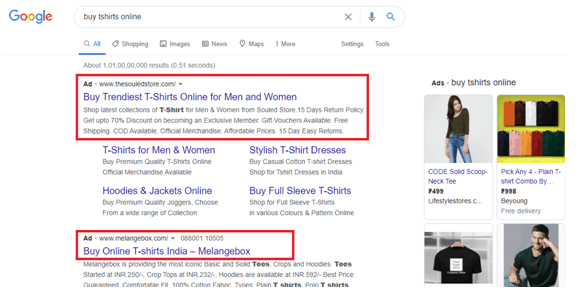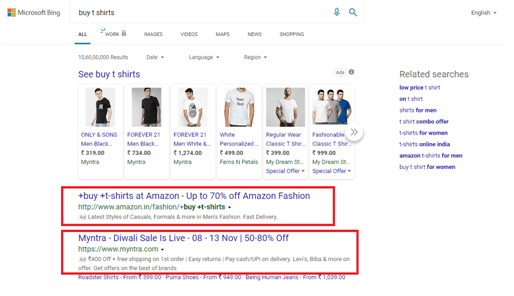Search Engine Marketing (SEM) is an important part of digital marketing.
SEM comprises marketing and promotional activities for websites and is done through paid methods. It is done to increase a businesses’ visibility in the search engine results pages (SERPs) of major search engines like Google, Yahoo, Bing, etc.
Search engine marketing (SEM) has developed more and more since the early 2000s as the internet became mainstream. To better understand what SEM is and how it works, let’s delve into some details.
What is search engine marketing?
SEM is based on SERPs, i.e., search engine results pages. Search engine results are the web pages that give internet users a product for their query while searching online on search engines like Google. When the user submits her/his search query, usually through words or phrases, the search engine gives her/him a SERP.
Now, SEM is used to increase your business website’s visibility or webpage in the result, as mentioned earlier, pages of major search engines through paid methods. Using paid strategies to grow your business’s visibility helps your brand appear at the top to many people, who, in turn, can become your potential customers.
By using SEM, you can significantly expand your business outreach by using multiple advertising techniques offered by search engines. But before delving into the numerous methods, it is essential to know the difference between SEM and another closely related marketing methodology – Search Engine Optimization (SEO).
While in SEM, you pay for advertising your business on SERPs, SEO is the process of enhancing your business website’s visibility in the unpaid results of a search engine. SEO is used for increasing the quantity and quality of users and customers that visit a business’s website through organic search engine results. Paid and unpaid advertisement is the crucial difference between SEM and SEO.
Components of SEM
Let us now come to the fundamental components of SEM, which are cost per impression (CPI), cost per click/ pay per click (CPC/PPC), and cost per action (CPA).
Cost per impression (CPI): It is the cost you pay to run a business’s advertisement on search engines. This cost is calculated for every one thousand images that your advertising has. An impression refers to a user viewing your advertisement online. Cost per impression is an essential parameter for monitoring the impact and effectiveness of your business advertisement.
Cost per click/ pay per click (CPC/PPC): Pay per click is the technique used to promote your business by creating a digital advertisement and paying a certain fee to the host (search engine) every time a user clicks on your advertisement. These ads appear when people search for things online.
Simply saying, search engines like Google charge money from you to show your business’s ad to a large pool of potential customers. These paid placements are typically located at the top or bottom of a web page. Some paid search ads may also appear as products in a featured carousel. Featured Carousel is a method of advertising content in a broader visual way by creating your products’ categories.
Cost per action (CPA): In CPA, you pay the host search engine, on which you want to run your business advertisement, for customer engagement with your website and products. Users click on your ad and sign up for a service like a free trial, register for a free download, or buy your product. Actions like signing up, registration, and buying from your website generate leads for your business, which, in turn, grows your customer base.
In CPA, you pay a fee for each specific marketing activity. For example, generating leads from the search engine might cost different from actual sales due to those digital advertisements, i.e., for sales, the hosting engine can charge you a set percentage of the sale amount.
Now that we have discussed the components of SEM, let’s understand how SEM works.
SEM Keywords
Keywords are the most critical element for performing search engine marketing activities. Keywords for SEM are the terms and phrases related to your business. And when users search these keywords, your digital advertisements pop up on their screen. Doing keyword research and finding words that are being used by your target audience gives you a fair chance of reaching out to a large share of the public.
Keyword research helps you in finding the most popular phrases related to your business and industry. This enables you to identify the top terms that your audience regularly searches for. Different tools can be used for this purpose, like Alexa Keyword Difficulty Tool, Google Keyword Planner, etc.
There are specific categories of keywords that you need to be mindful of while doing SEM activities. They are:
Broad Match Keywords: These terms and phrases target word variations, like synonyms, singular/ plural forms, or misspellings of a target term. For example, while targeting the broad match keyword training, an SEM campaign may also target words like trainings, teaching, instruction, etc.
Phrase Match Keywords: These keywords search for the exact term and any phrase before or after the target term. For example, when targeting the phrase match keyword training, an SEM campaign might also consider phrases like best training, training near me, find training center, teach, train, etc.
Exact Match keywords: These keywords are very closely associated with the target term. These closely related words include misspellings, singular/plural forms, abbreviations, rearranged words, paraphrases, etc. For example, when targeting keyword training, an SEM campaign might also consider terms and phrases like trainings, traing, train, trainsing, etc.
Negative Keywords: These keywords do not have to be included in your target keywords list. Negative keywords are the variations of the target term or phrases that are not necessary for your SEM campaign. Examples of negative keywords for the target word training might include training for astronaut, training science, assistance training, etc. These phrases might be denotatively similar to the target term, but they differ from the target term’s search intent.
Thus, targeting and researching keywords is essential as it helps your business advertisement show up on a search platform.
SEM Ad Campaigns: Setup and Analysis
An SEM Campaign is a paid-promotional activity done by using a search engine for your brand or business. Typically, an SEM campaign displays your ads in the search results searched for by users. SEM campaigns are run on the two most significant search engine platforms, which are Google and Bing.


Google Ads: Google Ads is the most widely used platform for SEM campaigns. With billions of searches every day, Google presents your business to the largest online audience through advertising campaigns.
Bing Ads: Bing Ads also has a wide reach of about 3 million users a day. This platform claims to reach out to a user base that Google doesn’t have access to.
‘‘
By using SEM, you can significantly expand your business outreach by using multiple advertising techniques offered by search engines.
SEM campaigns help you organise your ad accounts into larger themes related to specific products, services, target audience types, or promotions. The needs of a particular business decide an SEM ad campaign.
Each SEM campaign has its unique factors, mainly:
Goal: Increase sales of both online and physical stores, thus, increasing the sales profit.
Budget: Over-investing or under-investing is kept in check with a budget strategy in place.
Application Strategy: Your application strategy helps you in applying the campaign and its components effectively.
Review: Review of set goals help you analyse the effectiveness of ads in specific user segments. This enables you to make necessary adjustments to your SEM campaign.
Creating effective SEM campaigns requires research and strategy before setting up your campaign and after your campaign is already running. SEM campaigns help you reach more people within your budget and drive more customers towards your business.
For creating compelling SEM Ad campaigns, it needs to be effective and enticing enough to compel searchers to click on your ad. Following are some measure to get more users to click on your business’s ads in SERPs:
Use keywords in the ad;
Clearly communicate your message with users; mention the benefits or your brand provides;
Include relevant pricing and promotions;
Specify the call to action simply; and,
Use ad extensions.
Conclusion
In a nutshell, Search Engine Marketing provides you with the framework, tools, and processes for increasing your search engine visibility by securing higher rankings in the search results, which effectively increases your business footprint and profits simultaneously.
Similar to SEM is SEO – search engine optimization. It is the process of enhancing the website’s visibility in the unpaid results of a search engine. Read more about it on our website.




